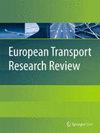What makes a railway station safe and for whom? The impact of transit environments on passengers’ victimisation and safety perceptions
IF 4.2
3区 工程技术
Q1 TRANSPORTATION
引用次数: 0
Abstract
This study assesses patterns of victimisation and safety perceptions among passengers using railway stations across neighbouring municipalities in Sweden. Exploratory data analysis and logistic regression models underlie the methodology of the study, which shows that the geography of passengers’ victimisation differs from the geographical patterns found for the perception of safety. Findings show that passengers’ safety perceptions are more affected by the physical and social characteristics of transit environments than passengers’ victimisation. Yet, for those who have reduced mobility, the station affects the likelihood of their being victimised. Lack of staff and poor maintenance of the station are two significant attributes associated with the lower levels of safety perceived by passengers as well as levels of crime and panhandling at both the station and on the way to it. Compared with all passengers, women, but in particular those who identify as LGBTQI+ /Non-binary/Other, run a higher likelihood of feeling less safe. The theoretical and practical implications of these results are discussed.是什么让火车站变得安全?过境环境对乘客受害情况和安全认知的影响
本研究评估了瑞典相邻城市火车站乘客的受害模式和安全认知。探索性数据分析和逻辑回归模型是研究方法的基础,研究结果表明,乘客受害的地理位置与安全感的地理位置模式不同。研究结果表明,与乘客的受害情况相比,乘客的安全感更多地受到公交环境的物理和社会特征的影响。然而,对于那些行动不便的人来说,车站会影响他们受害的可能性。车站缺乏工作人员和维护不善是乘客安全感较低以及车站和前往车站途中犯罪和乞讨水平较高的两个重要因素。与所有乘客相比,女性乘客,尤其是 LGBTQI+ /非二元/其他身份的乘客,更容易感到不安全。本文讨论了这些结果的理论和实践意义。
本文章由计算机程序翻译,如有差异,请以英文原文为准。
求助全文
约1分钟内获得全文
求助全文
来源期刊

European Transport Research Review
Engineering-Mechanical Engineering
CiteScore
8.60
自引率
4.70%
发文量
49
审稿时长
13 weeks
期刊介绍:
European Transport Research Review (ETRR) is a peer-reviewed open access journal publishing original high-quality scholarly research and developments in areas related to transportation science, technologies, policy and practice. Established in 2008 by the European Conference of Transport Research Institutes (ECTRI), the Journal provides researchers and practitioners around the world with an authoritative forum for the dissemination and critical discussion of new ideas and methodologies that originate in, or are of special interest to, the European transport research community. The journal is unique in its field, as it covers all modes of transport and addresses both the engineering and the social science perspective, offering a truly multidisciplinary platform for researchers, practitioners, engineers and policymakers. ETRR is aimed at a readership including researchers, practitioners in the design and operation of transportation systems, and policymakers at the international, national, regional and local levels.
 求助内容:
求助内容: 应助结果提醒方式:
应助结果提醒方式:


